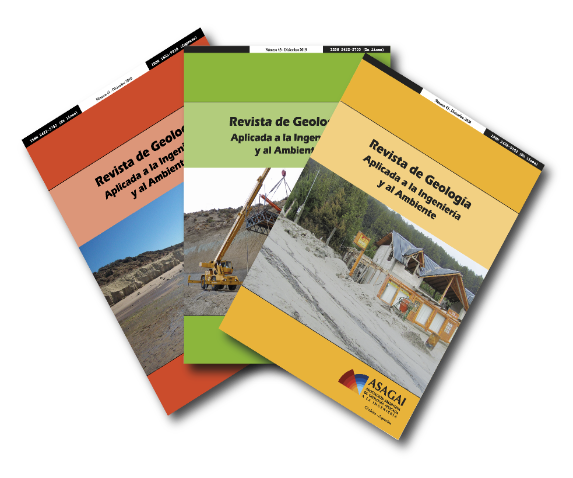Comportamiento del parámetro “b” de Gutenberg-Richter en los sismos de la región NOA. Argentina
Palabras clave:
sismicidad, parámetro “bâ€, frecuenciaResumen
La zona en estudio está ubicada en el Noroeste Argentino entre los paralelos 22° - 28° latitud sur y los meridianos 63° - 68°
longitud oeste exhibiendo una gran complejidad en su geodinámica. Los datos empleados provienen del United States
Geological Survey - National Earthquake Information Center (USGS), corresponden a registros instrumentales de actividad
sísmica, con magnitud mayor que 4, entre el 1 de Agosto de 1927 y el 31 de Marzo de 2012.
El número acumulado de eventos sísmicos versus sus correspondientes magnitudes sigue la Ley de potencia de Gutenberg-
Richter y se ajusta a una recta cuando se representa en escala semilogarítmica. El valor de la pendiente de ajuste de esta recta
se denomina “b” y es propio del proceso sísmico de una determinada área (M. A. Rodriguez Pascua et al, 2000).
Se distinguieron tres grupos: eventos superficiales con profundidades ≤ 70 km, intermedios entre 100 y 300 km y profundos
entre 500 y 600 km. El 85% de los sismos se encuentra entre los 100 y 300 km. Se calculó el valor de “b” para cada uno de
los niveles, resultando para los sismos superficiales b=0,7736, para los sismos intermedios b=0,813 y para los sismos
profundos b= 0,5364 con un valor mucho más bajo.
Citas
AKI, K. 1981.
A probabilistic synthesis of precursory phenomena.
In: Earthquake Prediction: An international Review, Maurice Ewing Ser. vol 4, edited by
W. Simpsom & P.G. Richards, pp. 566-574. Agu, Washington, D. C.
AKI, K. (1984).
Asperities, Barriers, Characteristic Earthquakes and Strong Motion Prediction.
Journal of Geophysical Research. 89. No.B7. 5867-5872.
FIGUEROA SOTO, A. (2009).
Análisis de tiempo interevento en secuencias de réplicas para la identificación de estados de relajación del esfuerzo.
Tesis en SismologÃa EstadÃstica de la Universidad Nacional Autónoma de México.
GUTENBERG, B. et al. (1944).
Frequency of earthquakes in California.
Bull. Seismol. Soc. Am. 34: 184-188.
GUTENBERG, B. et al. (1956).
Magnitude and energy of earthquakes.
Ann. Geofis., 9:1-15
HIRATA, T 1989.
A correlation between the b value and the fractal dimension of Earth.
Jour. Geophys. Res. 94, 36: 7507-7514.
ISHIMOTO, M. ET AL. (1939).
Observations sur les seism enregistres par le microseismograph construit dernierement (I).
Bull. Earthquake Res. Inst. 17: 443-478.
KAGAN, Y.Y. (1993).
Statistics of characteristic earthquakes.
Bulletin of the Seismological Society of America. 83. No. 1. 7-24.
KING, G. 1983.
The Accommodation of Large Strains in the Upper Lithosphere of the Earth and Other Solids
by Self-similar Fault System: the Geometrical Origin of b-Value.
Pure App. Geophys. 121: 761-815.
KOSSOBOKOV, V.G. ET AL. (2000).
Implications of a Statistical Physics Approach for Earthquake Hazard Assessment and Forecasting.
Pure and Applied Geophysics, 157. No. 11. 2323-2349.
LEGRAND, D. (2002).
Fractal Dimensions of Small, Intermediate, and Large Earthquakes.
Bulletin of the Seismological Society of America. 92. 3318-3320.
MOGI, K. 1962.
Study of the elastic shocks caused by the fracture of heterogeneous materials and its relations
to the earthquake phenomena.
Bull. Earthquake Res. Inst. 40: 125-173.
OKAL, E. A. et al. (1994).
On the variation of b-values with earthquake size. Phys.
Earth Planet. Interiors 87: 55-76.
OTSUKA, M. (1972).
A chain-reaction type source model as a tool to interpret the magnitude frequency relation of earthquakes,
J. Phis. Earth, 20, 35-45
RODRÃGUEZ PASCUA M.A. et al. (2000).
Similitudes entre la actividad sÃsmica actual y la paleosismicidad.
Revista Sociedad Geolog. España,13(3-4)
SHCHERBAKOV, R. et al. (2005).
Aftershock Statistics.
Pure and Applied Geophysics. 162. 1051 – 1076.
SCHOLZ, C.H. (1968).
The frequency-magnitude relation of microfracturing in rock and its relation to arthquakes.
Bulletin of the Seismological Society of America. 58. No.1. 399-416.
SUAYTER, L.E. (1983).
Sismicidad y Tectónica de los Andes del Norte Argentino.
Tesis Doctoral Facultad de Ciencias Naturales e Instituto Miguel Lillo, Universidad Nacional de Tucumán.
TURCOTTE, D.L. (1997).
Fractal and Chaos in Geology and Geophysics.
nd. Ed.Cambridge University Press.
VERE-JONES, D. (1976).
A. branching model for crack propagation,
PAGEOPH, 114, 711-725.
WESNOUSKY, S.G. (1994).
The Gutenberg-Richter or characteristic earthquake distribution, wich is it?.
Bulletin of the Seismological Society of America. 84. No. 6.1940-1959.
WIEMER, S. ET AL. (1997).
Mapping the frequency-magnitude distribution in asperities: An improved technique to calculate recurrence times?.
Journal of Geophysical Research B: Solid Earth, 102(B7), 15115-15128.
WIEMER, S. et al. (2002).
Mapping spatial variability of the frequency-magnitude distribution of earthquakes.
Advances in Geophysics. 45. 259-302.
ZOSSI, M.M. (1979).
Estudio de la Actividad SÃsmica de la Provincia de Tucumán.
Tesis de Licenciatura en FÃsica Facultad de Ciencias Exactas y TecnologÃa, Universidad Nacional de Tucumán.
ZÚÑIGA, F.R. et al. (2001).
Most- and Least-Likely Locations of Large to Great Earthquakes along the Pacific Coast of Mexico
Estimated from Local Recurrence Times Based on b-Values.
Bulletin of the Seismological Society of America 91 No. 6. 1717-1728.
ZÚÑIGA, F.R. et al. (2009).
A Seismotectonic Regionalization of Mexico for Engineering Purposes.
In process.
Descargas
Publicado
Cómo citar
Número
Sección
Licencia
Los autores conservan los derechos de autor y garantizan a la revista el derecho de ser la primera publicación del trabajo licenciado según una licencia de atribución https://creativecommons.org/licenses/by-nc-sa/4.0/deed.es
La Revista permite a los autores mantener el derecho patrimonial sobre su obra sin restricciones. Los autores se reservan el permiso de publicar y/o almacenar la versión aceptada de su artículo en cualquier tipo de repositorio o colección con la condición de citar explícita y adecuadamente, cada vez que sea utilizado, la fuente original de primera publicación (Revista de Geología Aplicada a la Ingeniería y al Ambiente)
















